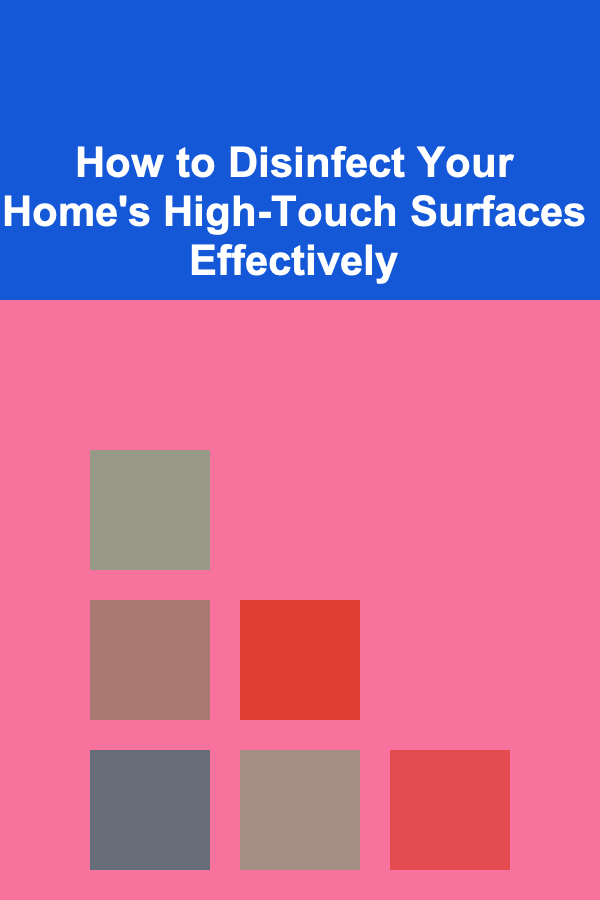
How to Disinfect Your Home's High-Touch Surfaces Effectively
ebook include PDF & Audio bundle (Micro Guide)
$12.99$9.99
Limited Time Offer! Order within the next:

Maintaining a clean and hygienic environment is an essential part of keeping your home safe and healthy. One of the most important aspects of home cleanliness involves disinfecting high-touch surfaces. These are surfaces that are frequently touched by hands, such as door handles, light switches, countertops, and bathroom fixtures. With the ongoing concerns about viruses, bacteria, and other pathogens, properly disinfecting these surfaces has never been more crucial.
In this comprehensive guide, we'll explore why high-touch surfaces require special attention, the most effective methods for disinfecting them, the products you should use, and some best practices for maintaining a germ-free environment. This article will also delve into common mistakes people make when disinfecting, providing you with expert tips to ensure your efforts are both efficient and effective.
Why High-Touch Surfaces Matter
High-touch surfaces are defined as areas that are frequently touched by people. These include places like kitchen counters, bathroom faucets, doorknobs, and even remote controls. These surfaces are particularly important to focus on because they are breeding grounds for bacteria, viruses, and other pathogens.
Every time you touch a surface, you can transfer germs from your hands onto it. Conversely, you may pick up germs from that surface and introduce them to other parts of your home or your body. High-touch surfaces are often found in shared spaces where multiple people are likely to come into contact with them, further increasing the risk of contamination.
Properly disinfecting these areas helps reduce the risk of infection, especially for illnesses like the flu, cold, and, more recently, COVID-19. Germs can linger on surfaces for varying periods, depending on their type, making regular disinfection a necessary practice for protecting your health and that of your loved ones.
Common High-Touch Surfaces in Your Home
Before we get into the specifics of how to disinfect high-touch surfaces, it's helpful to know exactly which areas in your home require attention. The following are common high-touch surfaces that should be disinfected regularly:
- Doorknobs and handles -- These are touched frequently by everyone in the household.
- Light switches -- Often overlooked, light switches can harbor germs and bacteria.
- Kitchen counters and dining tables -- Especially after meal prep or eating.
- Faucets and sink handles -- Frequently touched during handwashing, cleaning, and other tasks.
- Toilet handles and seats -- These are high-risk areas in terms of germ transmission.
- Remote controls, phones, and tablets -- Devices that are constantly handled by everyone in the house.
- Appliance buttons -- Microwave buttons, oven dials, and refrigerator handles are also common touchpoints.
- Handrails -- Stairs and hallways often have handrails that are regularly used.
- Cabinet handles and pulls -- In kitchens and bathrooms, cabinet handles are frequently touched, especially when cooking or cleaning.
By identifying these high-touch areas in your home, you can begin to form a routine for disinfecting them effectively.
How Germs Spread on High-Touch Surfaces
Germs can spread in a variety of ways, and high-touch surfaces play a significant role in transmission. When you touch a contaminated surface, you may inadvertently transfer those germs to your hands, clothing, or other items you handle. From there, the germs can spread further by coming into contact with other surfaces, food, or even your face.
The spread of viruses, bacteria, and other pathogens on surfaces depends on several factors, including:
- The Type of Germs: Certain germs, such as the flu virus, can survive on surfaces for several hours, while others, like COVID-19, can last much longer. Understanding the survivability of different germs helps determine how often high-touch surfaces need to be disinfected.
- Surface Type: Some materials, like stainless steel or plastic, can harbor germs for extended periods, while porous surfaces like wood or fabric may absorb germs more readily, but they don't allow them to survive as long.
- Human Behavior: High-touch surfaces are often contaminated when people eat, cough, sneeze, or touch their face. This is why regular cleaning and disinfecting are essential, especially in high-traffic areas.
Why Disinfecting is More Than Just Cleaning
Cleaning and disinfecting are often used interchangeably, but they are distinct processes. Cleaning refers to the physical act of removing dirt, dust, and debris from surfaces, while disinfecting goes a step further by killing germs and pathogens that may remain after cleaning.
While cleaning can remove a large portion of the contaminants, it does not necessarily eliminate all viruses and bacteria. Disinfecting, on the other hand, ensures that harmful germs are neutralized, making it crucial for high-touch surfaces where germs can be easily transferred from person to person.
Therefore, disinfecting your high-touch surfaces is key to preventing the spread of illness and ensuring your home remains as safe as possible.
Effective Methods for Disinfecting High-Touch Surfaces
Now that we understand the importance of disinfecting high-touch surfaces, let's look at some effective methods to do so.
1. Using Disinfectant Wipes
Disinfectant wipes are one of the most convenient ways to disinfect high-touch surfaces. They are pre-moistened with a disinfectant solution and are ready to use right out of the package.
How to use disinfectant wipes effectively:
- Choose wipes that are approved by regulatory agencies (such as the U.S. Environmental Protection Agency, or EPA) for disinfecting.
- Wipe the surface thoroughly, ensuring that the entire area is covered.
- Follow the manufacturer's instructions, including the recommended contact time (how long the disinfectant needs to sit on the surface to be effective).
- Avoid wiping the surface immediately after applying the wipe to ensure it remains wet long enough to kill germs.
2. Using Spray Disinfectants
Spray disinfectants are another popular choice for disinfecting high-touch surfaces. They tend to be more versatile and are effective for larger surfaces.
How to use spray disinfectants effectively:
- Apply the disinfectant spray evenly over the surface.
- Let the disinfectant sit on the surface for the recommended amount of time (this is usually specified on the product's label).
- Wipe the surface with a clean microfiber cloth to remove excess liquid, dirt, and grime.
- Ensure the surface is left dry after cleaning to avoid moisture buildup that could lead to mildew or mold.
3. Disinfecting with Natural Solutions
For those looking for more environmentally friendly or non-toxic options, natural disinfecting solutions can be effective alternatives. The two most commonly used natural disinfectants are vinegar and hydrogen peroxide.
- Vinegar: White vinegar can be mixed with water to create an effective cleaner for general disinfecting. It's particularly useful for cutting grease and removing stains.
- Hydrogen Peroxide: Hydrogen peroxide is a powerful disinfectant that can kill a wide range of germs. You can use it directly on surfaces, but it should be kept in its original bottle, as it degrades when exposed to light.
How to use natural disinfectants effectively:
- Mix vinegar and water in a 1:1 ratio for light cleaning. For stronger disinfecting power, use a more concentrated solution (e.g., 3:1 vinegar to water).
- Spray hydrogen peroxide on the surface and let it sit for at least 1 minute before wiping it down.
- Use clean cloths for wiping down surfaces and avoid reusing cloths that have been contaminated with germs.
4. Disinfecting with Soap and Water
While soap and water may not kill all pathogens, they are effective for cleaning surfaces before disinfecting. Soap works by breaking down oils and dirt that can harbor germs, allowing disinfectants to work more effectively.
How to use soap and water effectively:
- Wash high-touch surfaces with soap and warm water.
- Scrub with a soft sponge or cloth to ensure thorough cleaning.
- After cleaning, follow up with a disinfectant to kill any remaining germs.
Best Practices for Disinfecting High-Touch Surfaces
To ensure that your disinfection efforts are both effective and efficient, follow these best practices:
- Establish a Routine: Make disinfecting high-touch surfaces part of your daily or weekly cleaning routine. This ensures that germs don't have a chance to build up.
- Focus on Key Areas: Prioritize areas that are touched most frequently, such as doorknobs, light switches, and countertops. Pay special attention to surfaces in high-traffic areas like kitchens and bathrooms.
- Use the Right Disinfectant: Always use a disinfectant that is suitable for the surface you're cleaning. Avoid products that could damage your appliances or furniture.
- Clean Before You Disinfect: Dirt and grime can prevent disinfectants from working effectively, so always clean surfaces before applying a disinfectant.
- Let Disinfectants Sit: Allow disinfectants to sit for the recommended contact time (often between 3 and 10 minutes). This ensures that germs are properly killed before wiping them away.
- Wash Hands After Cleaning: After disinfecting, wash your hands thoroughly to remove any remaining germs that may have been transferred during the cleaning process.
- Use Microfiber Cloths: Microfiber cloths are ideal for wiping down disinfected surfaces. They trap dirt and bacteria without scratching surfaces and can be washed and reused.
- Disinfect High-Touch Surfaces Frequently: Especially during cold and flu season or when there's an outbreak of illness, increase the frequency of disinfecting high-touch areas.
Conclusion
Disinfecting your home's high-touch surfaces effectively is one of the simplest yet most impactful ways to maintain a healthy living environment. By focusing on high-risk areas such as doorknobs, light switches, and bathroom fixtures, and by using the right cleaning and disinfecting methods, you can significantly reduce the spread of germs and viruses.
With the right tools, products, and practices, disinfecting can become a regular part of your cleaning routine. Whether you opt for commercial disinfectants or natural solutions, it's important to ensure that all high-touch surfaces are cleaned, disinfected, and maintained regularly to protect the health of you and your loved ones.
Reading More From Our Other Websites
- [Personal Care Tips 101] How to Select a Sunscreen for Acne-Prone Skin
- [Organization Tip 101] Why Regularly Cleaning Out Your Fridge is Essential
- [Simple Life Tip 101] How to Design a Small Space Garden That Thrives with Minimal Effort
- [Home Soundproofing 101] How to Create a Home Theater with Exceptional Soundproofing
- [Personal Care Tips 101] How to Choose a Toner for Anti-Aging Benefits
- [Home Maintenance 101] How to Keep Your Home's Water Pressure Consistent
- [Home Budget Decorating 101] How to Transform Small Spaces to Make a House Feel Like Home on a Budget with Smart Layouts
- [Home Pet Care 101] How to Choose the Right Pet Insurance for Your Needs
- [Home Party Planning 101] How to Organize a Perfect Home Party with Themes and Food & Drink Ideas
- [Reading Habit Tip 101] Lifelong Learning: How Reading Enhances Career Success and Personal Growth

How to Understand Cryptocurrency as an Investment
Read More
The Best Deep Learning Tools for Generating Passive Income
Read More
Unlocking Passive Income through Deep Learning Models
Read More
How to Discover Series That Are Great for Character Study
Read More
How to Combat Multitasking for Improved Focus
Read More
How to Create Zentangle-Inspired Coloring Bookmarks
Read MoreOther Products

How to Understand Cryptocurrency as an Investment
Read More
The Best Deep Learning Tools for Generating Passive Income
Read More
Unlocking Passive Income through Deep Learning Models
Read More
How to Discover Series That Are Great for Character Study
Read More
How to Combat Multitasking for Improved Focus
Read More